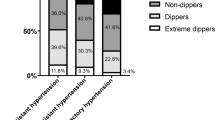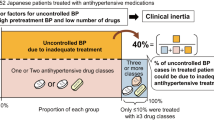Abstract
Resistant hypertension (RH) is defined as blood pressure (BP) that remains ⩾140 and/or 90 mm Hg despite therapy with ⩾3 full-dose antihypertensive drugs (classical definition=CD). A definition proposed subsequently (new definition=ND) includes patients requiring ⩾4 drugs irrespective of BP values. We aimed to evaluate whether both definitions characterize the same kind of patients.One hundred and twenty-four consecutively attended patients with RH were classified into two groups according to their BP control: 66 patients had non-controlled BP (all those who met the CD criteria plus a few patients who met the ND criteria); 58 patients had controlled BP (all with RH according to the ND). Clinical, laboratory and office BP data were recorded. RH patients with non-controlled BP were more frequently diabetic (72% vs 49%), and had higher plasmatic glucose (149 vs 130 mg dl−1), cholesterol (179 vs 164 mg dl−1), low-density lipoprotein (LDL)-cholesterol (107 vs 95 mg dl−1) and triglyceride (169 vs 137 mg dl−1) levels; P<0.05 for all comparisons. In multivariate logistic regression analysis, the variables that independently associated with non-controlled BP were diabetes (P=0.001) and higher LDL-cholesterol (P=0.007).We conclude that, although both cohorts of patients are phenotypically quite similar, uncontrolled RH patients have higher prevalence of diabetes mellitus and higher LDL-cholesterol levels than controlled RH patients.
This is a preview of subscription content, access via your institution
Access options
Subscribe to this journal
Receive 12 digital issues and online access to articles
$119.00 per year
only $9.92 per issue
Buy this article
- Purchase on Springer Link
- Instant access to full article PDF
Prices may be subject to local taxes which are calculated during checkout
Similar content being viewed by others
References
Acelajado MC, Pisoni R, Dudenbostel T, Dell'Italia LJ, Cartmill F, Calhoun DA et al. Refractory hypertension: definition, prevalence, and patient characteristics. J Clin Hypertens 2012; 14: 7–12.
De La Sierra A, Banegas JR, Oliveras A, Gorostidi M, Segura J, de la Cruz JJ et al. Clinical differences between resistant hypertensives and patients treated and controlled with three or less drugs. J Hypertens 2012; 30: 1211–1216.
De La Sierra A, Segura J, Banegas JR, Gorostidi M, de la Cruz JJ, Armario P et al. Clinical features of 8295 patients with resistant hypertension classified on the basis of ambulatory blood pressure monitoring. Hypertension 2011; 57: 898–902.
Persell SD . Prevalence of resistant hypertension in the United States, 2003–2008. Hypertension 2011; 57: 1076–1080.
Sim JJ, Bhandari SK, Shi J, Liu IL, Calhoun DA, McGlynn EA et al. Characteristics of resistant hypertension in a large, ethnically diverse hypertension population of an integrated health system. Mayo Clin Proc 2013; 88: 1099–1107.
Acharya T, Tringali S, Singh M, Huang J . Resistant hypertension and associated comorbidities in a veterans affairs population. J Clin Hypertens (Greenwich) 2014; 16: 741–745.
Calhoun DA, Jones D, Textor S, Goff DC, Murphy TP, Toto RD et al. Resistant hypertension: diagnosis, evaluation and treatment: a scientific statement from the American Heart Association Professional Education Committee of The Council for High Blood Pressure Research. Hypertension 2008; 51: 1403–1419.
Oliveras A, de la Sierra A . New developments in the diagnosis and management of resistant hypertension. Curr Med Chem 2012; 19: 1210–1218.
Chobanian AV, Bakris GL, Black HR, Cushman WC, Green LA, Izzo JL Jr et alNational Heart, Lung, and Blood Institute Joint National Committee on Prevention, Detection, Evaluation, and Treatment of High Blood Pressure; National High Blood Pressure Education Program Coordinating Committee. The Seventh Report of the Joint National Committee on Prevention, Detection, Evaluation, and Treatment of High Blood Pressure: the JNC 7 report. JAMA 2003; 289: 2560–2572.
Egan BM, Zhao Y, Axon N, Brzezinski WA, Ferdinand KC . Uncontrolled and apparent treatment resistant hypertension in the United States, 1988 to 2008. Circulation 2011; 124: 1046–1058.
Cuspidi C, Macca G, Sampieri L, Michev I, Salerno M, Fusi V et al. High prevalence of cardiac and extracardiac target organ damage in refractory hypertension. J Hypertens 2011; 19: 2063–2070.
Pierdomenico SD, Lapenna D, Bucci A, Di Tommaso R, Di Mascio R, Manente BM et al. Cardiovascular outcome in treated hypertensive patients with responder, masked, false resistant, and true resistant hypertension. Am J Hypertens 2005; 18: 1422–1428.
Salles GF, Cardoso CRL, Muxfeldt ES . Prognostic influence of office and ambulatory blood pressures in resistant hypertension. Arch Intern Med 2008; 168: 2340–2346.
Daugherty SL, Powers JD, Magid DJ, Tavel HM, Masoudi FA, Margolis KL et al. Incidence and prognosis of resistant hypertension in hypertensive patients. Circulation 2012; 125: 1635–1642.
Muxfeldt ES, Salles GF . Pulse pressure or dipping pattern: which one is a better cardiovascular risk marker in resistant hypertension? J Hypertens 2008; 26: 878–884.
Mancia G, Fagard R, Narkiewicz K, Redon J, Zanchetti A, Böhm M et alThe Task Force for the Management of Arterial Hypertension of the European Society of Hypertension (ESH) and of the European Society of Cardiology (ESC). 2013 ESH/ESC Practice Guidelines for the Management of Arterial Hypertension. Blood Press 2014; 23: 3–16.
De La Sierra A, Gorostidi M, Marin R, Redon J, Banegas JR, Armario P et al. Evaluation and management of hypertension in Spain. A consensus guide [article in Spanish]. Med Clin (Barc) 2008; 131: 104–116.
Lang RM, Bierig M, Devereux RB, Flachskampf FA, Foster E, Pellikka PA et al. Recommendations for chamber quantification. Eur J Echocardiogr 2006; 7: 79–108.
Nagueh SF, Appleton CP, Gillebert TC, Marino PN, Oh JK, Smiseth OA et al. Recommendations for the evaluation of left ventricular diastolic function by echocardiography. Eur J Echocardiogr 2009; 10: 165–193.
Cushman WC, Ford CE, Cutler JA, Margolis KL, Davis BR, Grimm RH et alALLHAT Collaborative Research Group. Success and predictors of blood pressure control in diverse North American settings: the antihypertensive and lipid-lowering and treatment to prevent heart attack trial (ALLHAT). J Clin Hypertens 2002; 4: 393–404.
Muxfeldt ES, Bloch KV, Nogueira AR, Salles GF . True resistant hypertension: is it possible to be recognized in the office? Am J Hypertens 2005; 18: 1534–1540.
Václavik J, Sedlák R, Plachy M, Navrátil K, Plásek J, Jarkovsky J et al. Addition of Spironolactone in Patients With Resistant Arterial Hypertension (ASPIRANT). A randomized, double-blind, placebo-controlled trial. Hypertension 2011; 57: 1069–1075.
Calhoun DA, Booth JN III, Oparil S, Irvin MR, Shimbo D, Lackland DT et al. Refractory hypertension: determination of prevalence, risk factors, and comorbidities in a large, population-based cohort. Hypertension 2014; 63: 451–458.
Garg JP, Elliott WJ, Folker A, Izhar M, Black HR . Resistant hypertension revisited: a comparison of two university-based cohorts. Am J Hypertens 2005; 18: 619–626.
Acknowledgements
We thank Sergi Mojal for his statistical guidance. This study was partially supported by the Spanish scientific research network REDINREN RD12/0021/0024.
Author information
Authors and Affiliations
Corresponding author
Ethics declarations
Competing interests
The authors declare no conflict of interest.
Additional information
Supplementary Information accompanies this paper on the Journal of Human Hypertension website
Supplementary information
Rights and permissions
About this article
Cite this article
Boswell, L., Pascual, J. & Oliveras, A. Resistant hypertension: do all definitions describe the same patients?. J Hum Hypertens 29, 530–534 (2015). https://doi.org/10.1038/jhh.2014.128
Received:
Revised:
Accepted:
Published:
Issue Date:
DOI: https://doi.org/10.1038/jhh.2014.128



